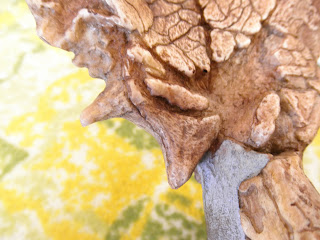
Ardi (more formally known as Ardipithecus ramidus) is a pretty cool gal. She's got some weird stuff going on with her feet (more on that in a moment) and her pelvis looks like one of those 3D puzzles that take FOREVER to complete. She's also got some stuff going on with her teeth that isn't so common to find in the fossil record.
Ardi has this super cool foot. It's not totally like a human foot yet, but is totally capable of supporting bipedal walking, though in this weird tri-pod sort of way. The foot doesn't have a bony arch built into it, instead Ardi used her muscles to pull her foot up into an arch in order to be able to go for a stroll bipedally. There are a couple of bits of bone evidence showing this, where you can clearly see the grooves where the muscles ran through and would pull on to make an arch.

The cuboid bone here shows the groove beautifully.

This is the talus, which is the bone that sits in between those knobs on your leg that you tend to call your ankle. It looks a lot like a human talus, and yet, it belongs to Ardi.

This one is the cream of the crop. From left to right we see chimp, Ardi, and human feet. Ardi definitely has the ability to wrap the feet around as a chimp would and obviously has no bony arch like a human foot.
There is another important comparative feature that Ardipithecus ramidus has that I took photos of, and that is the form of the sciatic notch. In a chimp, we don't see this notch, but in a human and other hominin forms it's one of the things that we know causes our hips to be short and broad and accommodating to bipedalism. Ardi most definitely possesses this notch, and as Dr. Kramer pointed out, it may be the one single bit of really GOOD evidence for bipedalism on that insane puzzle of an illium that we have for Ardi because it hasn't been pieced together from tiny fragments and it is absolutely in the correct place.

This is Ardi's sciatic notch.

Here we have a human. If you compare the two you can actually see that though Ardi's is on a smaller scale, they actually follow about the same curvature.

And here's the chimp. Notice the lack of any real distinguishable sciatic notch, which allows for a much taller illium.
So there we have Ardi, a really interesting specimen that is still really new to those of us studying human evolution. It's a really cool stop along the path to life as we know it.
No comments:
Post a Comment